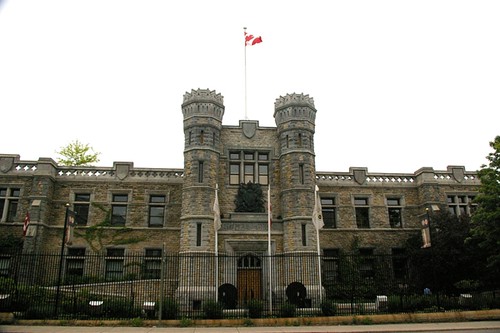
About UsThe Numismatic Bibliomania Society is a non-profit organization promoting numismatic literature. For more information please see our web site at coinbooks.org SubscriptionsThose wishing to become new E-Sylum subscribers (or wishing to Unsubscribe) can go to the following web page link MembershipThere is a membership application available on the web site Membership Application To join, print the application and return it with your check to the address printed on the application. Membership is only $15 to addresses in the U.S., $20 for First Class mail, and $25 elsewhere. For those without web access, write to: David M. Sundman, Secretary/TreasurerNumismatic Bibliomania Society AsylumFor Asylum mailing address changes and other membership questions, contact David at this email address: dsundman@LittletonCoin.com SubmissionsTo submit items for publication in The E-Sylum, just Reply to this message, or write to the Editor at this address: whomren@coinlibrary.com BUY THE BOOK BEFORE THE COINYou won't regret it! |
- WAYNE'S WORDS: THE E-SYLUM JUNE 8, 2008
- THE ASYLUM VOL 26 NO 2 IS AT THE PRINTER
- EVEN MORE ON THE 100 GREATEST WORKS OF AMERICAN NUMISMATIC LITERATURE
- MORE NOTES AND COMMENT ON THE E-SYLUM FORMAT
- THE E-SYLUM FEATURED IN JUNE 2008 BANK NOTE REPORTER
- BOOK REVIEW: A GUIDE BOOK OF U.S. TOKENS AND MEDALS BY KATHERINE JAEGER
- NEW BOOK: I'M CHET: THE AUTOBIOGRAPHY OF CHET KRAUSE
- NEW BOOK: EARLY UNITED STATES QUARTERS 1796 1838 BY STEVE M. TOMPKINS
- NEW BOOK: A GUIDE BOOK OF PEACE DOLLARS BY ROGER W. BURDETTE
- COIN CHAT RADIO PROGRAMMING IN JUNE 2008
- CIVIL WAR TOKEN JOURNAL EDITOR WILL MUMFORD STEPS DOWN
- 1935 NEWSREEL ON BALTIMORE GOLD COIN HOARD DISCOVERED
- MORE ON COLLECTOR TED NAFTZGER
- EVEN MORE ON LINCOLN AND CHASE
- ON THE SIGNIFICANCE OF ROYAL MINT DIE NUMBERS
- ON COIN METALS FROM SPACE AND PURPLE GOLD, THE GOLD-ALUMINUM COMPOUND
- TAXAY COIN WORLD ARTICLE FOUND
- BEACH MYSTERY COIN IDENTIFIED AS REPLICA OF THE PHAISTOS DISK
- QUERY: AMERICAN COLONIAL BILL OF EXCHANGE 1630-1740 SOUGHT
- POSTCARD FROM OTTOWA: ROYAL CANADIAN MINT PHOTO BY HOWARD BERLIN
- A ROYAL CANADIAN MINT INTERVIEW
- ARTICLE: KATRINA DESTROYED JEFFERSON DAVIS HOUSE CONFEDERATE CURRENCY
- ENGLISH TOWN PLANS PRIVATE CURRENCY: THE LEWES POUND
- ARIZONA QUARTER LAUNCHED IN STATE CAPITOL CEREMONY
- MORE ON THE NUMISMATICS OF THE LINCOLN HIGHWAY
- ALAN WEINBERG ON THE RAY ROUSE HALF CENT COLLECTION
- MEDIEVAL COIN TREASURE FOUND IN SOUTHERN BULGARIA
- COINS AS GIFTS: CROSSING GUARD GIVES STUDENTS DOLLAR COINS
- VICTORIA CROSS SOLD YEARS AGO; FAMILY NOW SELLING REMAINING MEDALS
- WWII VETERAN'S WAR MEDALS STOLEN
- IRAQ VET TATTOOS VICTORIA CROSS MEDAL ON HIS BACK
- A MUSICAL USE FOR COINS: THE PENNY TIMPANI
- FEATURED WEB SITE: CANADIAN PAPER MONEY ERRORS
WAYNE'S WORDS: THE E-SYLUM JUNE 8, 2008
 Among our recent subscribers are Philip
Bressett, courtesy of Ken Bressett, Edwin Johnston, and Michael Welborn, Jr. Welcome aboard! We now have 1,145 subscribers.
Among our recent subscribers are Philip
Bressett, courtesy of Ken Bressett, Edwin Johnston, and Michael Welborn, Jr. Welcome aboard! We now have 1,145 subscribers.This week we open with updates on the NBS print journal and survey of the 100 Greatest Works of American Numismatic Literature. Next, we have some new comments on The E-Sylum's new format and excerpts from a nice hobby newspaper article about us.
The book department has my review of Katie's Jaeger's new Whitman book on Tokens and Medals, announcements of Chet Krause's autobiography, Steve Tompkins' new book on Early U.S. Quarters, and Roger Burdette's new book on Peace Dollars.
In follow-ups from earlier newsletters, we have items on Ted Naftzger, Salmon P. Chase and Royal Mint die numbers. E-Sylum readers have also solved the mystery of an unusual "coin" found recently on a Florida beach.
Topics in the news include a proposed private currency in England, a coin find in Bulgaria, and a soldier who had the image of his Victoria Cross medal tattooed across his back.
To learn where hurricane Katrina destroyed $250,000 worth of Confederate currency, read on. Have a great week, everyone.
Wayne Homren
Numismatic Bibliomania Society
THE ASYLUM VOL 26 NO 2 IS AT THE PRINTER
Editor David Yoon informs us that the latest number of our print journal, The Asylum is at the printer (Vol 26, No. 2). Here are the contents:- Richard Jozefiak - Picture Postcard Set Tells the Story of Early Twentieth-Century British Royal Mint Coin Production
- Henry Morris - The Making of the Special Edition of Adams' and Bentley's Comitia Americana and Related Medals
- John W. Adams - The Medals of Admiral Vernon: A Bibliography
- Leonard Augsburger - Book Review: From Gothic Windows to Peacocks: American Embossed Leather Bindings, 1825-1855, by Edwin Wolf
EVEN MORE ON THE 100 GREATEST WORKS OF AMERICAN NUMISMATIC LITERATURE
Regarding the Numismatic Bibliomania Society survey on the 100 Greatest Works of American Numismatic Literature, David Gladfelter writes:MORE NOTES AND COMMENT ON THE E-SYLUM FORMAT
- John-Dominic Cadorini: "Love the new format and the photos!"
- John Isles: "I love the new format of the E-Sylum. More compact when printed out, easier to read, and illustrated! Keep up the good work!"
- David Tripp: "I just thought I'd drop you a quick note to let you know how incredibly impressed I am by your new format. Very classy indeed! Many, many congratulations."
- Anne E. Bentley: "The E-Sylum just keeps getting better and better. The content was always prime, and now the visuals have caught up. The new format is absolutely gorgeous and the wider column much easier to read. Congratulations to all involved in the metamorphosis!"
I also am much pleased to see the full column with of text (although you may still get some fleeting gripes about that!). And I like the links from the headlines to the articles -- very handy with the larger issues."
Vicken Yegparian of Stack's writes: "The new format is great and attractive, but I don't use The E-Sylum like I probably should. I print it out and read it on the subway, and then go back to specific items online as needed. It's great subway reading, because each piece is short - I don't get off the train feeling like I got cut off in the middle of things! "
We are looking into some changes on our end that might improve things for more readers, but it will take time - please bear with us. -Editor
THE E-SYLUM FEATURED IN JUNE 2008 BANK NOTE REPORTER
Then in the mid 1990s Wayne had the notion of starting an e-mail newsletter for members of the Numismatic Bibliomania Society. This group had been founded in 1979 to promote the study and collecting of numismatic literature. At each of the societys annual meetings Wayne would patiently ask for a show of hands to see who else had an email account. At his first call, cataloguer Michael Hodder was the only other person to own-up. When the two exchanged their email addresses, other members looked on in awe, convinced they were witnessing some secret ritual. Each subsequent year a few more hands would be raised until, at the 1998 meeting in Portland, nearly every hand shot up. Wayne grabbed a tablet of paper and passed it around and on 4 September 1998 the first issue of what is now called The E-Sylum was published as an e-mail message to 49 people.
Today Wayne finds he has a tiger by the tail. The E-Sylum has evolved into a weekly forum where, numismatic bibliophiles, researchers and just plain collectors congregate to exchange information and ideas about numismatics and numismatic research. Each issue is now read by over 1,100 subscribers in the USA, Canada, Mexico, England, Ireland, Wales, Germany, Denmark, Italy, Australia, New Zealand and elsewhere. These are the vital aficionados of world numismatics. They include top authors, curators and collectors from around the USA and across the globe. Waynes newsletter has been succinctly described as, a weekly cocktail party of the worlds top numismatic minds.
Topics come from all over the numismatic map - anything interesting is fair game. Obscure topics are welcomed. Over the years subjects have included contemporary newspaper accounts of new coinage, biographies of numismatic authors and personalities, celebrity numismatists, numismatic neer-do-wells, the largest numismatics books, counterfeiters, alternate currencies, rare medals, sunken treasure, archaeological finds, and coins placed under a ships mast or on a cadavers eyes.
BOOK REVIEW: A GUIDE BOOK OF U.S. TOKENS AND MEDALS BY KATHERINE JAEGER
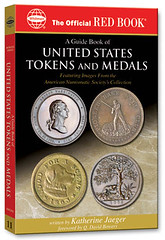 Whitman Publishing forwarded me a few
sample chapters of Katie Jaeger's upcoming book, A Guide Book of United States Tokens and Medals. It's an ambitious work that I feel will succeed in its purpose: introducing the
collecting of tokens and medals to a much wider audience. I'll look forward to seeing the book in regular bookstores, available to the general public.
Whitman Publishing forwarded me a few
sample chapters of Katie Jaeger's upcoming book, A Guide Book of United States Tokens and Medals. It's an ambitious work that I feel will succeed in its purpose: introducing the
collecting of tokens and medals to a much wider audience. I'll look forward to seeing the book in regular bookstores, available to the general public.It's an ambitious work because the subject field is so vast, which explains why so few authors have attempted to climb that mountain. Katie is an accomplished numismatic researcher, but she is a relative newcomer to our field, and maybe it took the fresh perspective of an outsider to look past the forest and see the magnificent trees. Jaeger's book does not attempt to cover every single subspecialty, but it does an excellent job of organizing and introducing the highlights of the field.
The first work I'm aware of that attempted to address the entire field was published in 1992 by Stephen P. Alpert and Lawrence E. Elman, Tokens and Medals: A Guide to the Identification and Values of United States Exonomia. Their 300-page softbound guide was divided into 67 chapters and three appendices, and was illustrated with black and white rubbings.
In 2003 the Token and Medal Society (TAMS) published a related work by Gregory C. Brunk titled Exonumia Journal Articles: A Guide for Identifying Tokens and Medals from the 1600s to Current Times. The 71-page unillustrated bibliography was published as a special issue of the TAMS Journal (Volume 43, No 1). The book covered not just the U.S., but the entire world.
Jaeger's Preface clearly states which categories of U.S. exonumia are NOT included, such as U.S. Military medals and decorations, sports medals and religious medals. The wide array of items which ARE included are organized very neatly into seven main parts, each of which has up to several chapters. Each chapter is further neatly divided into sections.
Though the casual reader will undoubtedly give little notice to the book's organization, I'm sure a great deal of thought and preparation went into designing its hierarchy and sequencing. Organizing this vast field into an easy-to-grasp taxonomy is no casual task. When I lived in New Jersey and told people where I was from, they often asked, "Which exit?" In the future, when someone mentions to a fellow numismatist that they collect tokens or medals, the response could well be "Which chapter?"
Chapter 3 covers one of my favorite areas, Civil War Tokens, encompassing Encased Postage Stamps, Token Currency, Patriotic Tokens, Store Cards, and Sutlers' Tokens. Chapter 8, Government-Sponsored Tokens covers Civilian Conservation Corps tokens, Alaskan "bingles", Sales Tax tokens, OPA ration tokens, internment camp tokens and food stamp change tokens.
 The publisher's web page describes the field this
way:
The publisher's web page describes the field this
way:
The book does not attempt to provide a checklist of known items of each type. Rather, it illustrates and prices a small illustrative selection of pieces.
Dennis Tucker of Whitman Publishing writes:
I'll look forward to seeing the complete book in print. I think Dennis is quite accurate in calling it "a good, readable, useable reference". I'm already thinking of buying a number of copies to distribute to young collectors as a way of introducing them to the wonders of exonomia.
The softcovered 6" x 9" book will be available in mid-June at a retail price of $19.95. See the Whitman Publishing web site for more information on A Guide Book of United States Tokens and Medals
NEW BOOK: I'M CHET: THE AUTOBIOGRAPHY OF CHET KRAUSE
The book is $20 plus $5 for shipping. To purchase, send payment to Iola Historical Society, P.O. Box 252, Iola, WI 54945. Checks should be payable to the Iola Historical Society. Inquiries can also be made by e-mailing ckrause@athenet.net or calling 715-445-5570. -Editor
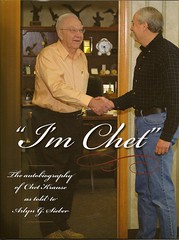 It is difficult to overstate Krause Publications founder and philanthropist Chet Krause's gifts
to Wisconsin and the world. From humble beginnings as a small-town carpenter to serving overseas during World War II to building a renowned publishing company from virtually nothing, Krause, an Iola
native, is a legend.
It is difficult to overstate Krause Publications founder and philanthropist Chet Krause's gifts
to Wisconsin and the world. From humble beginnings as a small-town carpenter to serving overseas during World War II to building a renowned publishing company from virtually nothing, Krause, an Iola
native, is a legend.At his sister's insistence, Krause published an autobiography, "I'm Chet," the proceeds of which will go to the Iola Historical Society.
"It took me a long time to be convinced I should write this," said Krause, 84. "Once I started, I just wrote, wrote, wrote."
While his story alone is impressive, Krause believes the book is successful in large part because of the skill of his editor and longtime colleague, Arlyn G. Sieber, and graphic artist Elizabeth Krogwold, who he says, "made me look good."
Krause has authored other texts including the multivolume Standard Catalog of World Coins as well as three books about Krause Publications' legacy and philosophy.
In addition to donating book proceeds to the society, Krause also recently provided them with two buildings for exhibits.
"I've known (Chet) since I was a little kid. Just in a small town growing up, everybody knew everybody ... There's a lot he's done that nobody knows about ... He's humble ... We're so grateful," said Iola Historical Society president Lyle Mork.
http://www.stevenspointjournal.com/apps/pbcs.dll/article?AID=/20080516/SPJ0101/805160734/-1/archive
NEW BOOK: EARLY UNITED STATES QUARTERS 1796 1838 BY STEVE M. TOMPKINS
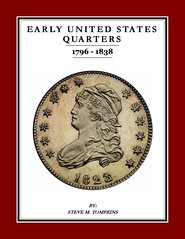 In this monumental new hardbound work, printed and bound in the U.S.A., you will find 448 pages
covering each year and the known die marriages for those years, along with background of the early mint. Included are quick finding charts and pictorials, as well as, oversized color photos of every
die marriage. Along with new rarity ratings and a new condition census, as an added bonus there are in-depth studies on the rare 1823s and 1827s.
In this monumental new hardbound work, printed and bound in the U.S.A., you will find 448 pages
covering each year and the known die marriages for those years, along with background of the early mint. Included are quick finding charts and pictorials, as well as, oversized color photos of every
die marriage. Along with new rarity ratings and a new condition census, as an added bonus there are in-depth studies on the rare 1823s and 1827s.The appendixes are chock full of interesting information on among other things, patterns, private re-strikes, error coins, and the mysterious E & L countermarks, along with several useful charts, die re-marriage listings, and much, much more!!
The finished book is slated to hopefully be back from the printer before the ANA show in Baltimore and is now on sale at an introductory pre-publication price of just $79.00 delivered. This price is only good until July 15th, at which time it will be raised to $89.00 plus postage. Get yours ordered today!
Please send all payments, comments and questions to:
Steve M. Tompkins
P.O. Box 1946
Sequim, WA 98382
Smt115@aol.com
NEW BOOK: A GUIDE BOOK OF PEACE DOLLARS BY ROGER W. BURDETTE
Dennis Tucker of Whitman Publishing writes:If any E-Sylum readers have unusual Peace dollars (errors, misstrikes, countermarks, etc.), they can contact me at dennis.tucker@whitmanbooks.com, and I'll forward their information to Roger. I'm attaching a media release.
Whitman Publishing, LLC, announces that award-winning researcher and writer Roger W. Burdette will author A Guide Book of Peace Dollars, to be published in November 2008.
Burdette is the author of the three-part Renaissance of American Coinage. Volume I (covering 19051908) and Volume III (19161921) won the Numismatic Literary Guilds Book of the Year awards for 2006 and 2007. He is also a contributor to the Guide Book of United States Coins (the Red Book), and has contributed research and insight to numerous other Whitman books.
The Guide Book of Peace Dollars is the 16th entry in Whitmans Bowers Series of numismatic references. It covers every date and mintmark of Americas last 90% silver dollar, which began as a commemorative of peace after the tribulations of World War One. The book also studies the mysterious 1964-D Peace dollar, as well as Proofs, patterns, trial pieces, errors and misstrikes, countermarks, die varieties, and famous collections.
Noted Peace dollar collector Barry Lovvorn assisted with the coin-by-coin study, interviewed past employees of the Denver Mint regarding the 1964-D issue, and contributed other research.
Burdette explores the origins and history of the Peace dollar (including the American Numismatic Associations involvement), early designs and casts, the coins production process, ways to collect, preservation, the market effect of hoards and meltings, and unusual examples. In addition to a coin-by-coin analysis that includes market values and certified population data, Burdette presents the biographies of key participants in the Peace dollars story, a Van AllenMallis cross-reference, a glossary, a bibliography, and a complete index.
A Guide Book of Peace Dollars will debut at 11 oclock, November 11, 2008the 90th anniversary of the official ceasefire that brought peace after the Great War. It will be available online at www.whitmanbooks.com, and in bookstores, hobby shops, and other retailers nationwide.
COIN CHAT RADIO PROGRAMMING IN JUNE 2008
- An "In the News" report by Coins magazine editor Bob Van Ryzin about the appointment of Andrew D. Brunhart as Deputy Director of the U.S. Mint;
- Michael R. Haynes, Chief Executive Officer of Collectors Universe, Inc., in a "Cutting Edge" interview with Numismatics Editorial Director Debbie Bradley;
- A look at the precious-metals market in "Gold Fever," as Numismatic News Editor Dave Harper talks to Scott Thomas, President and Chief Executive Officer of American Precious Metals Exchange;
- The latest in auction news in "Going Once" with Bank Note Reporter Editor Dave Kranz;
- An Industry insider profile by Debbie Bradley with coin supply dealer Jerry Potterfield of JP's Corner, Inc.;
- "Talking Type and Beyond" with Bob Van Ryzin about the 1848 "CAL." gold quarter eagle, which was minted from some of the first gold discovered in California.
Features of next week's "Collecting Money" (beginning June 12) include
- An "In the News" report by Coins magazine editor Bob Van Ryzin about a bill to mint commemorative silver dollars honoring disabled American veterans;
- An interview by Numismatics Editorial Director Debbie Bradley with Doug Davis, founder and president of Numismatic Crime Information Center, about NCICs investigative support to law enforcement and the numismatic community in all areas related to numismatic crimes;
- Numismatic News Editor Dave Harper with Donn Pearlman about the long-missing Walton specimen of the 1913 Liberty Head nickel;
- Auction news in "Going Once" with Bank Note Reporter Editor Dave Kranz;
- An interview by Debbie Bradley with Regina Hunter of Ducks in a Row about the firm's Keep It Safe! inventory software;
- "Talking Type and Beyond" with Bob Van Ryzin about the Ezra Meeker coin (the Oregon Trail half dollar);
- World Coin News Editor Maggie Pahl with details of suggested designs for the 2009 District of Columbia quarter in "Freshly Minted."
To listen, go to http://www.coinchatradio.com/

THE BOOK BAZARRE
CIVIL WAR TOKEN JOURNAL EDITOR WILL MUMFORD STEPS DOWN
The Summer 2008 issue of the Civil War Token Journal produced by the Civil War Token Society (CWTS) noted that1935 NEWSREEL ON BALTIMORE GOLD COIN HOARD DISCOVERED
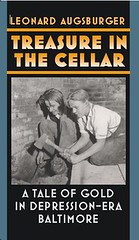 Len Augsburger reports the discovery of a 1935
Universal newsreel covering the Baltimore gold hoard, located at the National Archives in College Park, MD. Depicted in the newsreel are the gold coins, the decaying container, and the two boys who
located the hoard digging in a tenement cellar. The video will be included in Len's Numismatic Theatre presentation at the American Numismatic Association convention next month. Len's new
book on the hoard, Treasure in the Cellar: A Tale of Gold in Depression-Era Baltimore is scheduled to go on sale at the convention.
Len Augsburger reports the discovery of a 1935
Universal newsreel covering the Baltimore gold hoard, located at the National Archives in College Park, MD. Depicted in the newsreel are the gold coins, the decaying container, and the two boys who
located the hoard digging in a tenement cellar. The video will be included in Len's Numismatic Theatre presentation at the American Numismatic Association convention next month. Len's new
book on the hoard, Treasure in the Cellar: A Tale of Gold in Depression-Era Baltimore is scheduled to go on sale at the convention.MORE ON COLLECTOR TED NAFTZGER
Pete Smith writes:As I research biographies, I find that coin collectors are often successful in business. Sometimes I can find more information through professional sources than I can find in numismatic sources. With Ted Naftzger, I found little biographical information through either type of source and he did not respond to my request for information.
Somewhere I heard that Ted shared his birthdate with Myles Gerson and included that in my booklet, Names With Notes. For many years I was unable to find the birthdate for either. A great official source is the Social Security Death Index. Today I looked up Roy Naftzger and found his date of birth as August 23, 1925. I double checked on Myles Gerson and found that he was born eight days earlier so they shared the month of birth but not the date. This is not the first and will probably not be the last error I have published.
Some of my friends in EAC say that Naftzger knew he did not hold clear title to some of his choice cents. Still, I feel he was also a victim in his dispute with the ANS. I believe his love for the hobby soured and he withdrew from the numismatic community. This may be one reason why his family did not notify the numismatic media of his death.
When EAC founder Herb Silberman died, I received e-mail notification within the first day and had forwarded material for his obituaries before the end of the second day. When EAC legal counsel Milton Pfeffer died, it was months before that information got back to the club. This past Christmas, I learned that my last surviving uncle had died several months earlier and my sister and I were not notified at the time. Like so much with research, there is great diversity in the ways people choose to reveal biographical information.
Denis Loring writes:
Ted had an incomparable collection, and was generous to many people in many ways. He also perpetrated multiple frauds upon his fellow collectors. If he is to be remembered, let it be in the full light of day.
EVEN MORE ON LINCOLN AND CHASE
The historian, Doris Kearns Goodwin, referenced two secondary sources for that contention, one an obscure 19th century item and the other the contemporaneous writings of a journalist, Noah Brooks. I didn't have access to the former but promised to check out the citation for the latter when I returned home. I did so, and discovered I had a different volume of Brooks' writings, so I went out and drummed up the book Ms Kearns Goodwin cited, which arrived yesterday. Here is exactly what Brooks wrote in a section describing his impressions of Lincoln's cabinet members:
I fail to see how this substantiates in any way the contention that Chase had ulterior motives that involved the currency designs of the United States.
ON THE SIGNIFICANCE OF ROYAL MINT DIE NUMBERS
Regarding the question on Royal Mint die numbering, Martin Purdy writes:Here's a detailed link from Tony Clayton's website, which is a must to consult for any queries regarding UK coinage: http://www.tclayton.demon.co.uk/dieno.html
David Lange writes:
I skimmed through some of the Royal Mint reports from the 1870s and, while I could not find such a statement, I did see frequent references to the average numbers of coins obtained from dies for particular denominations. It seems that the Royal Mint was somewhat obsessed with this subject at the time, and numerous experiments were conducted to identify the best steel alloys for die making. Since the practice of numbering the dies ended in 1880, I paid particular attention to that year's report, and indeed it states that a satisfactory solution had been found. Again, there was no mention of the tiny numbers punched into dies, but the report suggests that such experiments were no longer needed after that time.
ON COIN METALS FROM SPACE AND PURPLE GOLD, THE GOLD-ALUMINUM COMPOUND
Joe Boling writes: "Regarding minting coins of new alloys - forget it. Any such experiments in space will involve milligrams of metal. You will never see quantities brought back sufficient to go into production - most likely never enough for even a single piece."Bill Malkmus writes: Regarding Dick Johnson's article on going into outer space to try to alloy gold and aluminum - unless my rudimentary knowledge of metallurgy fails me, these two metals are already commercially alloyed (and have been for over a century). I believe that a purple color can be obtained from that alloy.
To learn more, see: Purple Gold
TAXAY COIN WORLD ARTICLE FOUND
Last week Paul Withers wrote on behalf of a friend seeking a photocopy of an article by Don Taxay that appeared in Coin World decades ago.Paul writes:
It prompts me to mention that for 35 years I corresponded with Fred Pridmore. He was a remarkable person who always answered letters so fast that his reply invariably came return of post. Nowadays though, we have the tremendous advantage of the internet, which means that others can share in the correspondence, and replies are virtually instantaneous, and can be accompanied by a high-resolution image of the coin being discussed.
How much my friend misses by not trying to become computer literate. I could certainly recommend him becoming a reader of The E-Sylum. My thanks to you, to Kenneth Bressett and to The E-Sylum.
Ken adds:
Another option is offered by Amanda DeWees of Whitman Publishing, who adds:
BEACH MYSTERY COIN IDENTIFIED AS REPLICA OF THE PHAISTOS DISK
Bill Daehn writes:
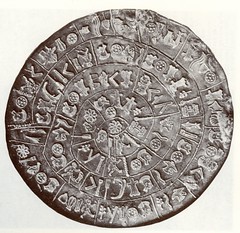 Regarding the "unusual coin found on Florida beach," of course it is not a coin at all. It
is a cheap souvenir sold in museum shops around the world. It is a miniature metallic imitation of the famous "Phaistos disc." The Phaistos disc is a circular, inscribed clay tablet found
in 1908 near a Minoan palace on the island of Crete. The object makes a nice souvenir and conversation piece. But unfortunately, it is not ancient and it is not a coin.
Regarding the "unusual coin found on Florida beach," of course it is not a coin at all. It
is a cheap souvenir sold in museum shops around the world. It is a miniature metallic imitation of the famous "Phaistos disc." The Phaistos disc is a circular, inscribed clay tablet found
in 1908 near a Minoan palace on the island of Crete. The object makes a nice souvenir and conversation piece. But unfortunately, it is not ancient and it is not a coin.John-Dominic Cadorini adds:
John Isles writes:
 This appears to be a tourist reproduction of the Phaistos Disk, perhaps bought as a souvenir in
Greece. See the Wikipedia article on the original, http://en.wikipedia.org/wiki/Phaistos_Disc, for the story of this still-undeciphered artifact from Minoan Crete. You can in fact buy a reproduction
of it for $8 from this website: http://sacredearthdesigns.com/Symbols/Pendants/Festos.htm though it's a different one than that shown in the E-Sylum.
This appears to be a tourist reproduction of the Phaistos Disk, perhaps bought as a souvenir in
Greece. See the Wikipedia article on the original, http://en.wikipedia.org/wiki/Phaistos_Disc, for the story of this still-undeciphered artifact from Minoan Crete. You can in fact buy a reproduction
of it for $8 from this website: http://sacredearthdesigns.com/Symbols/Pendants/Festos.htm though it's a different one than that shown in the E-Sylum.Jonathan Brecher writes:
This sort of thing raises an interesting question -- how would someone go about identifying an object like this from its picture? I recognized it, then found a picture online to confirm my memory. If I didn't recognize it off the bat, I wouldn't have had a clue how to identify it otherwise. For something as distinctive -- literally unique -- as this one, there ought to be a way to come up with an identification that doesn't involve finding someone who happens to recognize it. I can't come up with an approach that would work, though, it just feels like there should be one.
I'd be curious to hear how many others also identified it. It isn't a huge stretch from numismatics to archaeology. With 1000+ readers, I'd expect other folks to recognize it also.
THE JOB BAZARRE
QUERY: AMERICAN COLONIAL BILL OF EXCHANGE 1630-1740 SOUGHT
Anne E. Bentley of the Massachusetts Historical Society writes: "Would anyone out there have an example of a Colonial American bill of exchange (all manuscript or printed with manuscript) dating between 1630 and 1740 inclusive? One of our readers is looking for an example to use as an illustration in an upcoming book, and our bills of exchange date from 1763 upwards -- too late for his subject. Thanks!Our reader is Mark Valeri and he can be reached at MValeri@union-psce.edu if anyone can help him out.
POSTCARD FROM OTTOWA: ROYAL CANADIAN MINT PHOTO BY HOWARD BERLIN
A ROYAL CANADIAN MINT INTERVIEW
Germans are big buyers of silver Maple Leafs, 55% of current production is sold to Germany.
Silver for these coins come from Canadian mines, and recycled sources. The Royal Canadian Mint has capacity for refining both silver and gold for their products.
RCM produces 125,000 silver Maple Leafs each week.
Demand is very strong for gold Maple Leafs -- "we sell all that we can produce."
RCM has increased its refining capability of gold to produce a 99999 gold coin (what the industry calls "five 9s gold"). Previously it struck four 9s fine gold bullion coins and this became the industry standard. "To stay ahead of our competitors, we created a new design for the 2008 five 9s gold Maple Leaf to be released this summer," said Mr Madge.
RCM currently produces eight million silver bullion coins a year. It plans to increase this by two million more bullion coins for the 2010 Vancouver Winter Games. "Given the present demand," said Mr. Madge, "I believe there will still be shortages in the market well into 2009."
Platinum Maple Leafs were struck in the past, but suspended due to lack of demand. "Given the high cost of platinum there were a great number of old coins being bought by dealers from the secondary market" he said. "We would produce more platinum Maple Leaf coins if the orders were there. A few years ago we introduced a palladium maple leaf and continue with that product as demand requires." To read the full interview on silberinfo, see: Silberinfo Interview with Royal Canadian Mint
ARTICLE: KATRINA DESTROYED JEFFERSON DAVIS HOUSE CONFEDERATE CURRENCY
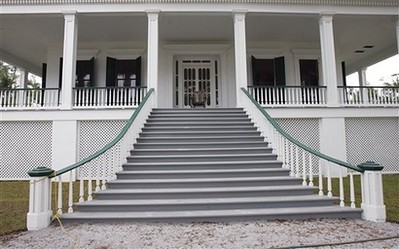 A popular tourist attraction before Katrina, Beauvoir was one of the few historic structures on
Mississippi's Gulf Coast to survive the Aug. 29, 2005, hurricane albeit with plenty of bumps and bruises.
A popular tourist attraction before Katrina, Beauvoir was one of the few historic structures on
Mississippi's Gulf Coast to survive the Aug. 29, 2005, hurricane albeit with plenty of bumps and bruises.Storm surge ripped apart the front porch. Eight inches of water flooded the home's living quarters, leaving mold on the walls and peeling away some of the paint on the murals. All told, roughly 30 percent of the house was gone.
Other structures on the 52-acre property, including a guest cottage and gift shop, were a total loss. The storm also washed away about one-third of Beauvoir's artifacts, including some of Davis' manuscripts and about $250,000 worth of Confederate currency.
"If that storm had lasted another hour, I don't think we would have had anything left," said Richard Forte, Beauvoir's board chairman. "God was looking over this place."
To read the complete article, see: Biloxi: Jefferson Davis home, Beauvoir, to reopen
ENGLISH TOWN PLANS PRIVATE CURRENCY: THE LEWES POUND
Bill Collison: It's a quirky little town with lots of unusual stores with interesting things going on and obviously, the currency is another quirky idea that makes people relate to a town they live in and obviously a new currency is fun, isn't it?
 A coffee shop, a clothing store and a brewery are among the local
businesses eager to take part. The thinking is that locals will spend their Lewes pounds. The shopkeepers will then use the currency to buy supplies and so the money will circulate, keeping the
wealth within Lewes. Plans for this curious idea are quite advanced.
A coffee shop, a clothing store and a brewery are among the local
businesses eager to take part. The thinking is that locals will spend their Lewes pounds. The shopkeepers will then use the currency to buy supplies and so the money will circulate, keeping the
wealth within Lewes. Plans for this curious idea are quite advanced.The organizing committee meets to mull over the design of the new pound note, which will be worth 1 British pound.
She and her fellow residents dream of a world in which local communities do a lot more things locally. The Lewes pound, designed and produced by local volunteers, could be the first step.
To read the complete story, see: Don't leave home with it
ARIZONA QUARTER LAUNCHED IN STATE CAPITOL CEREMONY
The official Arizona quarter launch took place outside the Arizona State Capitol, at an event complete with local celebrities. Mariachi Aguila from Phoenix entertained the crowd, and the ceremony was emceed by Beth and Bill of 99.9 KEZ.
Wells Fargo, the bank sponsor for the unveiling, made available a free, uncirculated Arizona quarter to each child under 18. Adults could exchange their bills for uncirculated quarters in $10 rolls, commemorative folios for $10 and limited edition folios for $20. Event participants were treated to free mint ice cream drumsticks in honor of the U.S. Mint, and could explore the Capitol Museum, which featured two new exhibits documenting the quarter from conception to circulation.
To read the complete article, see: Arizona quarter unveiled
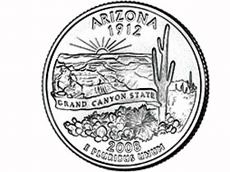 Monday's official release at the Capitol mark the end of a
process that began three years ago when Gov. Janet Napolitano selected coin collectors, state officials, educators and even some elementary school students to figure out what the Arizona coin should
look like.
Monday's official release at the Capitol mark the end of a
process that began three years ago when Gov. Janet Napolitano selected coin collectors, state officials, educators and even some elementary school students to figure out what the Arizona coin should
look like.That panel reviewed more than 4,200 design suggestions from across the state before coming up with five finalists. These were sent to the U.S. Mint which produced the actual drawings.
Napolitano, who got the final word, decided to conduct a nonscientific online poll, eventually choosing the one that gained the most votes: A picture of the Grand Canyon and a saguaro cactus, with the motto of "Grand Canyon State'' in between. That placement was not accidental but instead designed to show that the signature cactus can be found nowhere near the canyon.
To read the complete article, see: Arizona quarter goes into circulation
MORE ON THE NUMISMATICS OF THE LINCOLN HIGHWAY
On page 187, the authors recount a tale of an alleged, locally famous robbery that happened near Big Spring, Nebraska. "On a moonlight night, Sam Bass, a lawman-turned-brigand, and five companions swept down on the eastbound train stopped to pick up mail. The outlaws made off with $60,000 in shiny $20 gold coins newly minted in San Francisco... A monument in Big Springs recounts the story of the robbery." The coins are reportedly buried nearby, but none are known to have been discovered, according to the authors. A historical marker in Brule, near Big Springs, notes that the Lincoln Highway was built on a route traveled by many gold seekers and others in wagon trains heading west from 1841 to 1860.
On page 210, the authors report of damage to a monument to U.S. Congressman Oakes Ames and his brother Oliver, the third president of Union Pacific. Architect Henry Hobson Richardson created the 60-foot-high pyramid standing in "the middle of nowhere." It can be found near the summit of Sherman Hill, west of Tree Rock, Wyoming. Bas-relief medallions by Augustus Saint-Gaudens "caught the eye of sagebrush marksman, who have shot away both men's noses."
Middlegate, Nevada is the site of a most interesting "bank," as reported on page 260. The ceiling of Old Middlegate Station, a gas station/bar/grocery/campground is littered with several thousand pieces of paper money from all over the world. The "bank" dates to old mining days when the bartender was a bank. After writing the owner's name on the money, the bartender would pin it to the ceiling for safekeeping. When they needed some, the bartender would retrieve it. The authors report that money from China, Switzerland, Russia, and Japan, and many other foreign nations, is stored on the ceiling. A special section is reserved for U.S. Navy fliers stationed at nearby Fallon.
Another train robbery, reportedly one of the first in the West, is reported on page 265. In 1870, John Chapman and others boarded the Central Pacific Overland Express train near Verdi, Nevada, and stole $41,000 in gold coins. They were later caught and convicted.
The final numismatic note tells of a Lincoln Highway marker in Lincoln Park in San Francisco, which bears a medal of Abraham Lincoln. No further information about the piece is given.
ALAN WEINBERG ON THE RAY ROUSE HALF CENT COLLECTION
Aside from the fact that each coin had an impressive pedigree including one superb 1794 C-1a ex-Brobston , original pedigree auction envelopes will be available for many of them. While the collection was no Walt Husak large cent collection with its many finest knowns and non-collectible varieties, the uniform attractiveness of the "raw" half cents on exhibit and available for fingertip examination was visually and uniformily impressive. I do not impress easily, having attended too many shows and major auctions over the past 50+ years but I found myself drooling a bit. Planchet color and delightful non-porous glossy surfaces and high but still-affordable grade seemed to be a goal consignor Ray Rouse strived for. Excellent color fliers picturing perhaps 3 dozen auction highlights were distributed at Long Beach and they alone were enough to stir the blood. A beautiful run of 1793's, an eye-opening VF 1796 NO pole, a really nice 1802 rev 1800 and a run of very attractive 1794's are just a sampling. I found myself going back several times to the two bourse cases holding the raw half cents.
But here's the kicker. The coins will be sold RAW, graded by EAC standards by Bob Grellman with nary a whiff of slabs or slab grading! I love it! You'll be able to see the rims, toss the coins in the light to appreciate the surfaces, and trust in the grading ! Almost unprecedented today !
Bob Grellman will start cataloguing almost immediately and now the coins are "off the market" for examination until cataloguing is complete. Just as well. They'll need a light oiling and brushing before being put out again for examination. One dolt already left his big greasy fresh fingerprint on a 1794. Easily brushed off but you just wonder why some collectors cannot properly handle raw coins when coins aren't slabbed. Gad!
This sale will be something to anticipate ...and save for.
MEDIEVAL COIN TREASURE FOUND IN SOUTHERN BULGARIA
 Treasure of 79 golden and silver coins was found by archaeologists in a rock crack near the Rodopi
mountain Gulabovo village.
Treasure of 79 golden and silver coins was found by archaeologists in a rock crack near the Rodopi
mountain Gulabovo village.The coins were found at hardly 30 cm underground in a rock's crack, covered with stones.
The crack is in the bases of a Thracian sanctuary, which was functioning as a Christian temple.
To read the complete article, see: Medieval Coin Treasure Found in Southern Bulgaria
COINS AS GIFTS: CROSSING GUARD GIVES STUDENTS DOLLAR COINS
"It's a collector's item," she said. "I know some of the children said, yes, they're going to collect them [and] save them."
She said the others "most likely will spend them," as in the case of 8-year-old Jason Laning.
"I like it because the coin is one dollar," he said. "I think I'm going to spend it on a toy."
To read the complete article, see: For last day of school, students get $1 coins
VICTORIA CROSS SOLD YEARS AGO; FAMILY NOW SELLING REMAINING MEDALS
The family of a war hero who was forced to sell his Victoria Cross 30 years ago are auctioning his other medals in the hope of reuniting them all.Major Patrick Porteous was awarded the VC Britains highest military honour by King George VI in 1942.
After his death aged 82 in 2000 his family tried to track down the original medal but were unsuccessful.
They have decided to put the rest of the collection up for auction in the hope that the publicity will flush out the missing VC.
Major Porteous daughter Didie Hall, 50, said: My father sold the VC about 30 years ago without telling anyone, and he wore a replacement.
It would be really nice to get the medals back together. My mother died in February and she had been trying to track down the VC.
His other medals, to be auctioned at Lewes, East Sussex, next week, are the 1939-45 star, France and Germany star, Defence Medal, War Medal, General Service Medal with Malaya and Palestine clasps, Coronation Medal and Jubilee Medal.
To read the complete article, see: BATTLE TO FIND A HERO'S VC - FAMILY BID TO REUNITE MEDALS
WWII VETERAN'S WAR MEDALS STOLEN
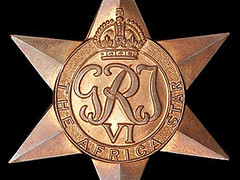 Police are in the midst of investigating the theft of a Second World War veteran's
medals...
Police are in the midst of investigating the theft of a Second World War veteran's
medals...Five war medals were stolen when the elderly victim - who served in the British Army - attended an event at the Canadian Legion on Legion Road in Burlington on May 23. He carried them to hall in a black box to have them professionally mounted.
Someone snatched the precious awards from a table while his back was briefly turned.
Police say these British medals are in excellent condition and one of them is extremely rare. The victim had one of only 1,000 British Army Palestine Medals in existence. That particular medallion is cast bronze with an inscription around the edge.
To read the complete article, see: 85-Yr.-Old Veteran's War Medals Stolen
IRAQ VET TATTOOS VICTORIA CROSS MEDAL ON HIS BACK
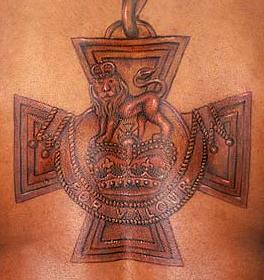
War hero Johnson Beharry had his Victoria Cross tattooed on his back and says it hurt more than being blown up.
The brave driver, 28, was awarded Britains top military gong after saving 30 comrades lives in two ambushes.
He suffered horrific head injuries in a blast inches from his face but said the five visits to his local tattooist were WORSE.
Lance Corporal Beharry said: Having this tattoo done was the worst pain I have experienced in my life. I suffered more for this than being in the blast.
I just had to grit my teeth and think of the British Army.
L/Cpl Beharry is the first living soldier to get the VC in 40 years. He says he got the tattoo so he never has to take it off.
To read the complete article, see: Tattoo agony worse than being blown up
A MUSICAL USE FOR COINS: THE PENNY TIMPANI
A penny whistle is well known in South Africa, but penny timpani?
Audiences were treated to penny timpani during the performances of the Johannesburg Philharmonic Orchestra this week after Welsh guest conductor Grant Llewellyn snubbed South African money.
The programme included British composer Edward Elgar's Enigma Variations and in one of the variations the timpani or kettle drums have to be played with coins, instead of the normal drumsticks, to depict the sound of a ship's engines.
JPO trumpet player Berndt Baumann said on Friday that when rehearsals started on Tuesday, the timpanist used South African R2 coins.
But that did not satisfy the conductor.
"I used to be a coin collector, so I went home and looked in an old box and found just the right pennies."
One of the British copper pennies used by the timpanist is dated 1899, the year the Enigma Variations premiered and depicts Queen Victoria. The other is from 1902 and features the head of King George.
FEATURED WEB SITE: CANADIAN PAPER MONEY ERRORS
http://www.rarenotes.net/

